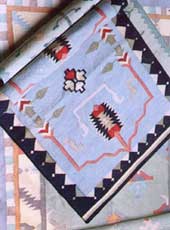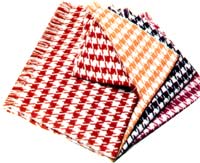|
 Floor
Coverings : Floor
Coverings :
Floor coverings have been made from textile
fibers for more than five thousand years.
India produces a wide range of handloom cotton
floor coverings such as 'galichas', 'durries',
druggets, prayer rugs, hooked rugs, 'gabbas'
and 'namdas'. Among these hand-woven articles
the durrie is the most common and is used
not only as an ordinary floor covering but
also for ceremonial occasions such as feasts
and prayers. The rapid growth and progress
of the floor covering industry in recent years
has resulted in a large range of complex geometrical,
floral, figurative patterns as well as traditional
designs combined with ethnic motifs. With
the recent American demand, durrie weaving
has become a large industry in India. 90%
of the durries available in European and American
markets are woven in India. The states of
Haryana and Punjab are noted for their production
of picturesque cotton durries. Durrie weaving
is still a sizable cottage Industry in the
handloom centers in Haryana, Ludhiana, Amritsar,
Jalandhar and Pathankot. Other centers for
durrie weaving are Bhavani in Tamilnadu, Amroha,
Agra, Farrukhabad and Hathras in Uttar Pradesh,
Bikaner in Rajasthan, Eluru, Adoni, Warrangal
and Kurnool in Andhra Pradesh and Jagdalpur
in Madhya Pradesh. '
 Handwoven Carpets :
Carpet weaving on handlooms came into vogue
during the last decade and is gaining popularity
since the product is attractive and comparatively
cheap. Unlike hand knotted and tufted carpets,
the productivity of carpets on handlooms is
high and free from allegations of child
labour. Hathras in Uttar Pradesh is famous
for the manufacture of these Chennile pile
rugs. Among the handloom centers in North
India producing floor coverings, Panipat is
famous for durries and other heavy varieties
where hand-spun yarns are increasingly used. Handwoven Carpets :
Carpet weaving on handlooms came into vogue
during the last decade and is gaining popularity
since the product is attractive and comparatively
cheap. Unlike hand knotted and tufted carpets,
the productivity of carpets on handlooms is
high and free from allegations of child
labour. Hathras in Uttar Pradesh is famous
for the manufacture of these Chennile pile
rugs. Among the handloom centers in North
India producing floor coverings, Panipat is
famous for durries and other heavy varieties
where hand-spun yarns are increasingly used.
|